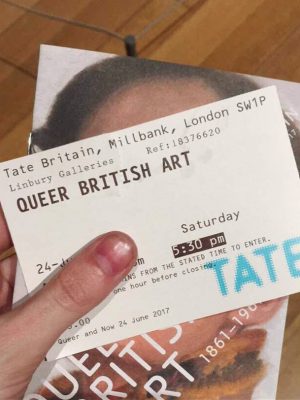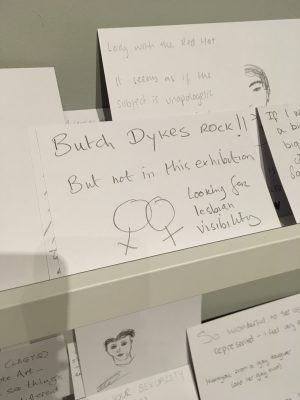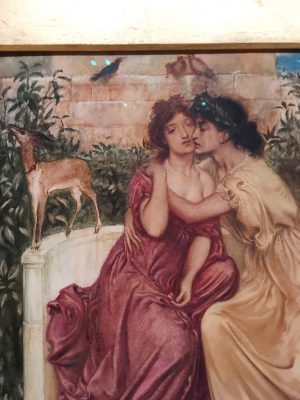Queer British Art at the Tate
Simeon Solomon’s “Sappho and Erinna in a Garden at Mytilene” (1864) While male homosexuality was criminalized in the U.K. until 1967, female homosexuality was never criminalized because female sexuality was completely erased. (NADINE SANTORO/THE OBSERVER)
June 28, 2017
You don’t normally expect to encounter strobe lighting and drag queens in six-inch heels at a museum, but that’s exactly the environment I walked into at the Tate Britain on Saturday night, damp from the rain. I had planned my visit to the Queer British Art exhibition on the same evening as the Pride in London festival kickoff, an all-day celebration inside the museum including live DJs, film screenings, craft stalls, workshops on topics like makeup and masculinity, food and drinks. Weaving my way through the crowd of dancing bodies, I finally reached the information desk, purchased my ticket, and pushed back through the party towards the art.
When the heavy double doors of the exhibition closed behind me, I was plunged into complete silence. The dark walls and stark layout of the room stood in disorienting contrast to the vibrant, glittering party outside, giving the space a sobering vibe. The exhibition, featuring British art from 1861 to 1967, is the first of its kind—fifty short years ago, male homosexuality was still criminalized in the U.K., and artworks featuring themes of same-sex desire, even implicitly, were censored. According to the Tate’s website, the collection seeks to explore “how artists expressed themselves in a time when established assumptions about gender and sexuality were being questioned and transformed.”

The exhibition is separated into different rooms by theme and time period, and features not only visual art such as painting and photography, but also includes artifacts from British LGBT history. The second room, themed “Public Indecency,” focuses mainly on Oscar Wilde, with a large portrait of the author alongside his personal effects in a glass case, telling the story of his trial. The door of the prison cell that Wilde lived in during his incarceration for “gross indecency” is mounted on the wall, serving as a chilling reminder of the institutional violence gay people faced, and, in many parts of the world, continue to face, for loving each other.
For me, the most interesting—and in many cases, troubling—facet of the exhibition was not the art itself, but the language used to describe the art on the placard next to each work. Hesitant to assign modern identity labels to historical figures who did not have access to the language we do today, the exhibition groups all the art and artists featured under the umbrella term “queer,” historically a slur that has been only recently reclaimed by many members of the LGBT community. The website states that, according to their research, queer “is preferable to other terms for sexualities… no other option captured the full diversity of sexualities and gender identities that are represented in the show.” While many people who struggle to define their sexuality or gender find comfort in the purposely vague word “queer,” not everyone’s identity is fluid. Assigning “queer” to every LGBT person featured in the exhibition creates ambiguity where there often isn’t any; for example, labeling a woman who only had relationships with other women “queer” can serve to erase the specificity of her identity, implying that she might have some interest in men.
Patrick Staff, an artist quoted in the exhibition as a “well-known LGBT figure” was in favor of the unifying nature of the word “queer.” A placard with his reaction to a self-portrait by the artist Gluck reads “Queerness renders categories like ‘woman,’ ‘butch,’ ‘lesbian’ or ‘transsexual’ imperfect, historical, temporary and arbitrary.” Confoundingly, he seems to imply that “queer” is not only a more accurate word for the past, but that identities like “woman” didn’t exist historically. Interestingly, “queer” is just as much a modern label as “lesbian” or “transgender” are—it wasn’t until the early 1990s that people started referring to themselves as queer and the field of queer theory was born.

At the end of the exhibition, there were several shelves mounted on the walls displaying notes left by visitors with reactions, comments and critiques of the collection. Many were short messages of pride (“Gay + Muslim + Fabulous!”), others were funny (“The best ally is my cat”), while several were more thoughtful, offering in-depth critiques of the exhibition: its focus on almost exclusively white artists and white subjects, the discomfort many visitors had with the word queer being applied so broadly, the lack of representation for lesbians, bi people and trans people.
I left the exhibition feeling frustrated and emotionally drained—I had spent the past 45 minutes staring into the eyes of butch women whose bravery and visibility made it possible for me to be living openly as a lesbian today, but the institution refused to recognize them and their contributions to art and civil rights as part of the lesbian tradition. Emerging through the doors of the quiet exhibition, I rejoin the pride party, immediately hit with a wall of sound, color and life. Amidst dancing bodies of all ages, genders and sexualities, I’m comforted by the plurality of my community—whatever violence we face, and however we’re erased, we’ll keep existing in all our beautiful diversity.













